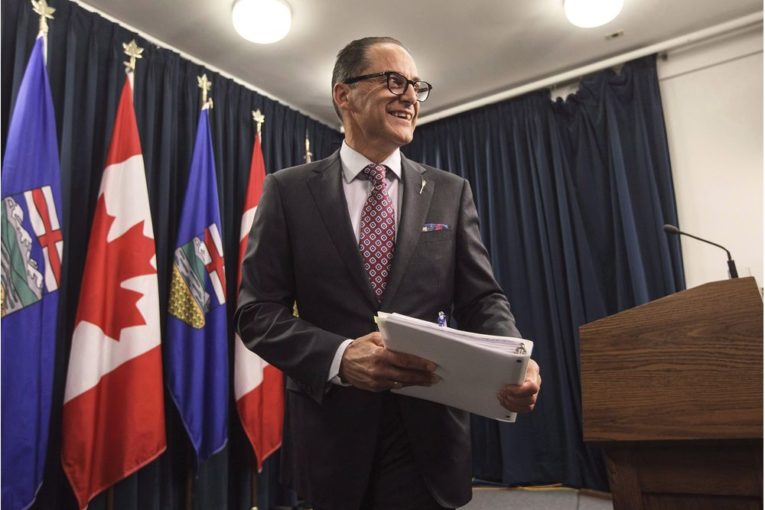
Up and down, up and down — watching a yo-yo is mesmerizing if you stare at it long enough.
The same holds true for gyrating energy prices and the impact they have on the Alberta government’s finances.
There’s been plenty of earnest talk about the province getting off the royalty roller-coaster since the recession began, but precious little progress.
Provincial finances still depend heavily on the direction of oil and natural gas prices.
The second-quarter fiscal update released Tuesday is a testament to that fact — as is a new credit rating downgrade for Alberta issued on Wednesday.
At the legislature, Finance Minister Joe Ceci said the province now expects the deficit to reach $10.3 billion this year, off slightly — about $183 million — from the first quarter’s estimates.
Since the budget year began on April 1, benchmark West Texas Intermediate oil prices have averaged about US$49.50 a barrel, down from the spring budget’s forecast of $55.
Thankfully, crude prices have rallied in recent weeks and are much higher than last year’s dismal lows, when oil plunged below US$30 a barrel — and the provincial economy shrank by 3.7 per cent.
In fact, oil prices continue to affect everything from jobs, investment and overall economic growth to the levels of corporate and personal income taxes paid into provincial coffers.
As oil prices have rebounded this fall — closing Tuesday at US$57.99 a barrel, although the province’s price forecast curiously remains at $49 — Alberta’s gross domestic product (GDP) is now expected to increase by four per cent in 2017-18, Ceci said.
The fiscal update also points out 41,000 of the 62,000 jobs lost during the recession have been regained.
While the unemployment rate remains high at 7.8 per cent, the government anticipates overall employment growth of one per cent this year and 1.5 per cent in 2018.
( function() { pnShowVideo( “1_8ne7fug3”, 115102, “”, “”, false, “”, “”, “kaltura”, “video”, null, null, “”, false ); } )();
Other areas of the economy are also improving.
After two years of recession, pent-up demand to buy new furniture, trucks and cars has returned with a vengeance. Stores are buzzing and retail sales are up eight per cent year to date.
The number of housing starts expected this fiscal year has been hiked to 28,700 units from 24,500.
But where are the new jobs coming from? Mainly from areas of the economy that shed employment during the recession, said the finance minister.
If you look at when employment peaked in September 2015 to the trough in July 2016, the mining, forestry, oil and gas sectors lost 27,500 jobs. These sectors have seen 20,000 positions created since that low point.
Another 8,000 new jobs have come from the manufacturing industry, which dropped 24,000 jobs during the downtown.
For thousands of Albertans hunting for work, it’s positive to see more help-wanted ads. From a diversification standpoint, however, there’s little evidence the makeup of the employment base has shifted dramatically.
“The (jobs) that were lost are coming back, so that’s in the oil and gas sector, that’s in the affiliated trades,” Ceci told reporters.
“They came back first, probably in the oil and gas sector, because they were lost first, but they’re going to be diversifying across the economy as diversification takes hold.”
That’s a hopeful sentiment, but it will take a long time for the province’s diversification efforts to take root.
Ceci cited the government’s petrochemical program, which will see Alberta provide up to $500 million in royalty tax credits to build two new plants, as an example of tangible diversification in action.
Yet, neither one of those two mega-projects has received the final go-ahead from their owners.
On the energy front, the fiscal update is a mixed bag of sorts.
Bitumen royalties are $671-million less than expected, but conventional oil and gas royalties are exceeding estimates.
One of the most positive indicators is a surge in the sale of Crown drilling rights, usually a precursor to future exploration work.
Petroleum producers have also benefited from narrower light-heavy oil differentials this year (although it has widened recently).
The forecast price for Alberta natural gas has been slashed to $2.20 per gigajoule from $2.90 in the budget.
The fact remains Alberta still needs a big increase in oil and gas prices to get close to balancing its books.
Related
“The government is relying on royalties as much as ever and, in fact, much more so than immediately prior to the recession,” said University of Calgary economist Trevor Tombe.
“The minister represented it today numerous times that they’re making progress on getting off the royalty roller-coaster, and that is just false.”
After reviewing the fiscal update, credit rating agency DBRS downgraded Alberta’s long-term debt rating on Wednesday to AA from AA (high), citing the province’s large operating deficits and rapid accumulation of debt.
The agency said it is “concerned that the plan to return to balance relies on a recovery in resource revenues, rather than fundamental adjustments to the budget.”
While Ceci says he’s now looking for places to further control government costs, it’s obvious energy prices will remain a driving force in future budgets.
We can all watch oil prices yo-yo around in the coming months to see the impact it makes on the province’s bottom line.
But let’s not mistake such movement for real budget action.
Chris Varcoe is a Calgary Herald columnist.
You can read more of the news on source
